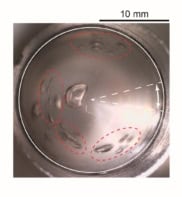Mass extinctions may have less to do with evolution and more to do with the inter-relationships between prey and their food, according to two US physicists. Luis Amaral of the Massachusetts Institute of Technology and Martin Meyer of Boston University have developed a computer model that simulates the growth and collapse of different evolving species across a wide range of environmental niches, from prey up to predators. In the model, whole groups of species become extinct either through random changes in the environment, such as falling meteorites, or through their food source disappearing. The model is the first to simulate the mass extinction patterns seen in the fossil record (Phys. Rev. Letts. . 82 652).
Many biologists have argued that most species become extinct when new ‘fitter’ competitors arrive on the scene. For example, some scientists believe the dinosaurs became extinct after a large meteorite hit the Earth 65 million years ago because warm-blooded mammals were better able to survive the long cold spells that followed. However, palaeontologists now argue that the collapse of the dinosaurs’ food sources had a bigger impact on the species than competition from mammals. The new computer model proves that mass extinctions are more dependent on an amplification effect between predators and their prey than any other factor.



